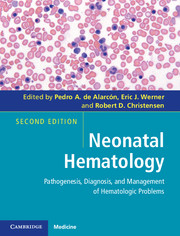Book contents
- Frontmatter
- Contents
- Contributors
- Foreword
- Preface
- 1 A historical review
- Section I Developmental hematology
- 2 Hematopoiesis
- 3 Development of the immune system
- Section II Erythrocyte disorders
- Section III Platelet disorders
- Section IV Leukocyte disorders
- Section V Immunologic disorders
- Section VI Hemostatic disorders
- Section VII Transfusional medicine
- Section VIII Miscellaneous
- Index
- Plate section
- References
2 - Hematopoiesis
from Section I - Developmental hematology
Published online by Cambridge University Press: 05 February 2013
- Frontmatter
- Contents
- Contributors
- Foreword
- Preface
- 1 A historical review
- Section I Developmental hematology
- 2 Hematopoiesis
- 3 Development of the immune system
- Section II Erythrocyte disorders
- Section III Platelet disorders
- Section IV Leukocyte disorders
- Section V Immunologic disorders
- Section VI Hemostatic disorders
- Section VII Transfusional medicine
- Section VIII Miscellaneous
- Index
- Plate section
- References
Summary
Hematopoiesis refers to the continuous production of circulating blood cells. From early in embryonic life to our final days on Earth, newly formed cells enter the circulation while injured, senescent, and tissue-recruited cells are withdrawn. Nearly 200 billion red blood cells, 10 billion white blood cells, and 400 billion platelets are produced daily throughout a normal lifetime. In addition to the requirement for high cell production, the concentration of individual blood cell lineages is precisely regulated in the peripheral blood and tissues. The production and use of circulating blood cells increase during periods of altered homeostasis such as defense against infection or replenishment of circulating red cells after hemorrhage. When the tightly regulated production of blood cells fails, the host may encounter life-threatening anemia or other cytopenias or suffer from excessive neoplastic growth of blood cells manifesting as leukemia.
Blood cell production is developmentally regulated and tissue specific. Blood cells are produced in several different tissues during human development, with each tissue having a characteristic pattern of blood cell production that is regulated in part by the nonhematopoietic cells in residence. This important relationship between nonhematopoietic tissue stromal elements and hematopoietic cells in regulating tissue-specific cell proliferation and differentiation is most evident during the embryonic period.
- Type
- Chapter
- Information
- Neonatal HematologyPathogenesis, Diagnosis, and Management of Hematologic Problems, pp. 11 - 24Publisher: Cambridge University PressPrint publication year: 2013
References
- 1
- Cited by



